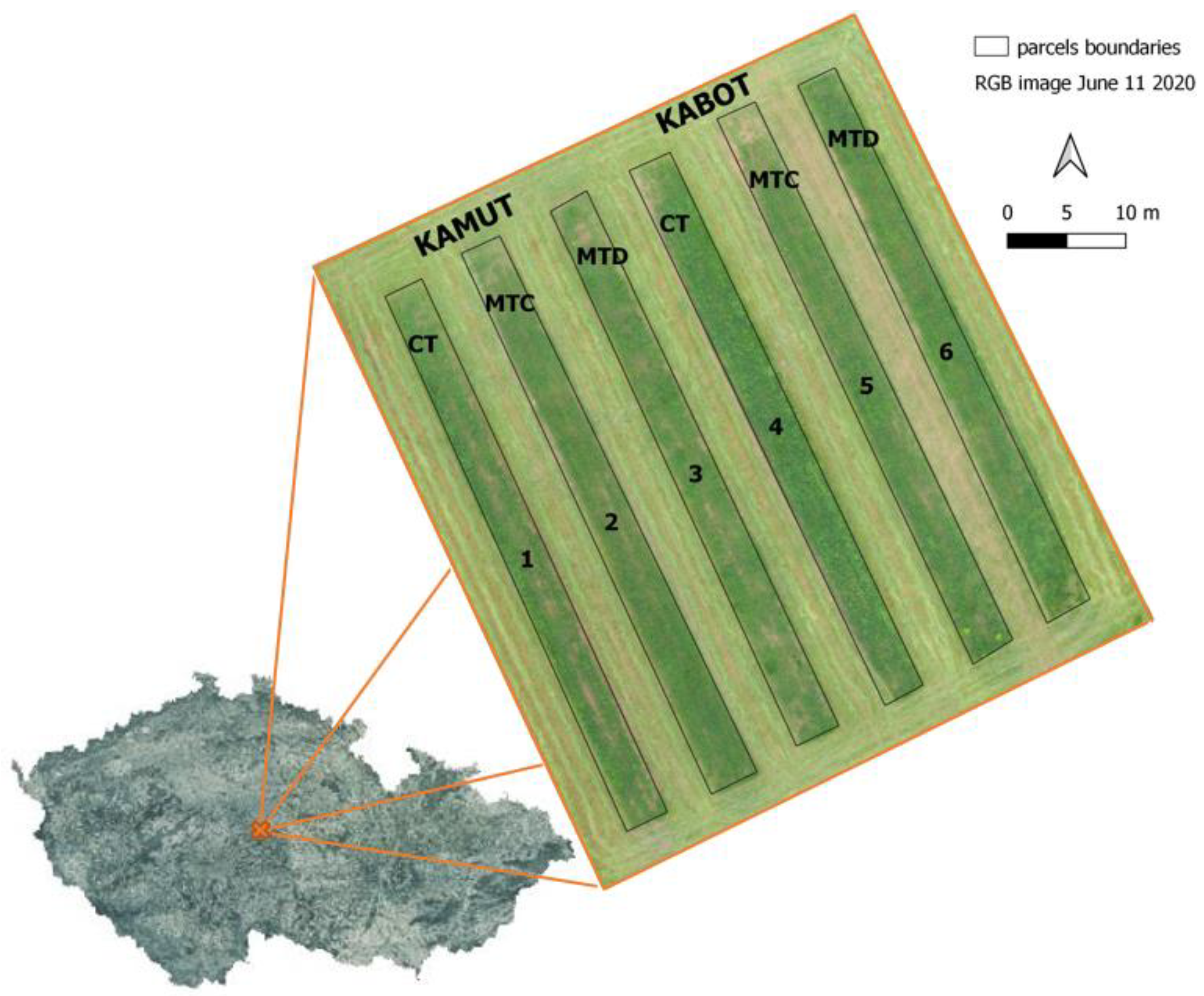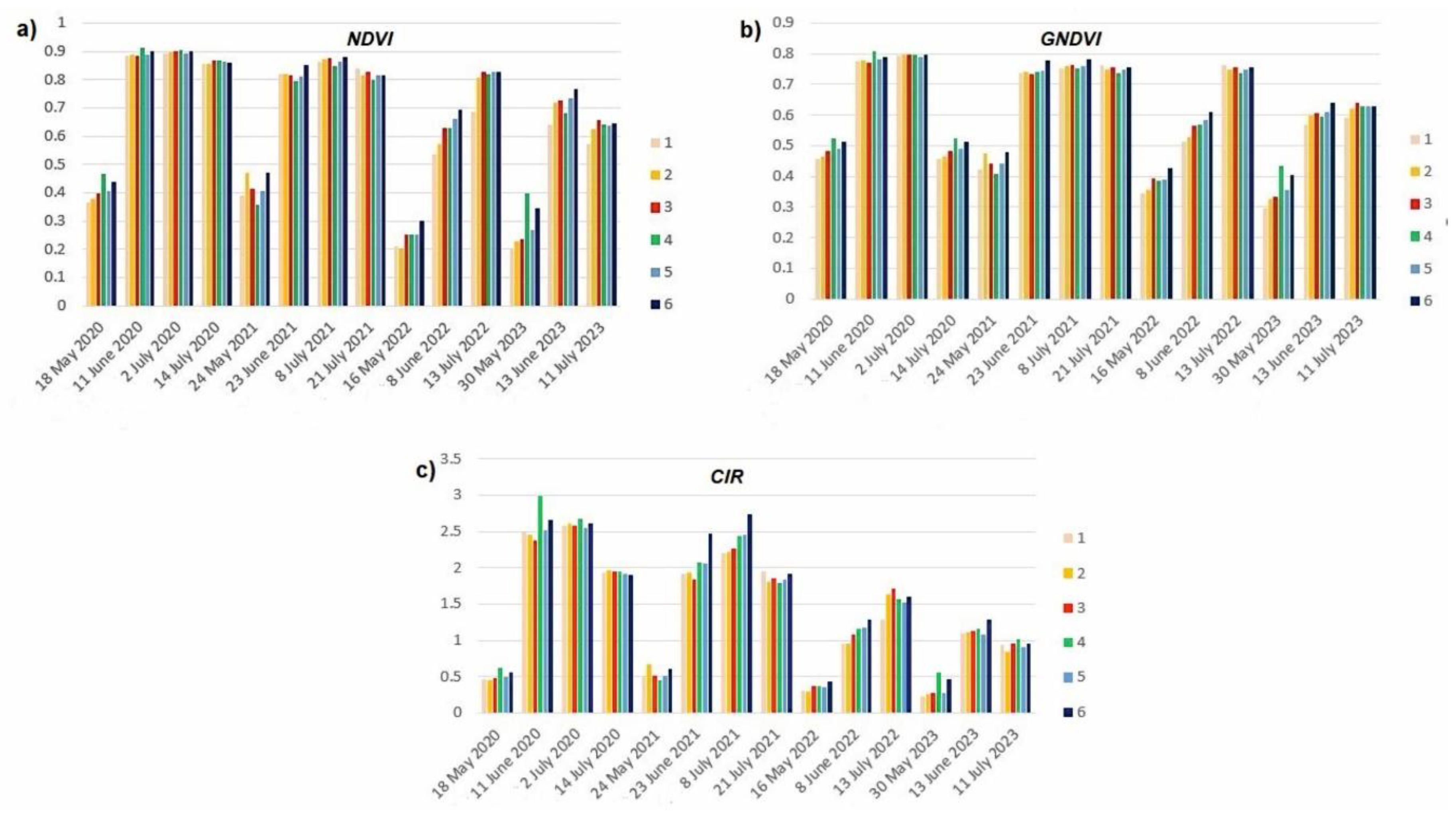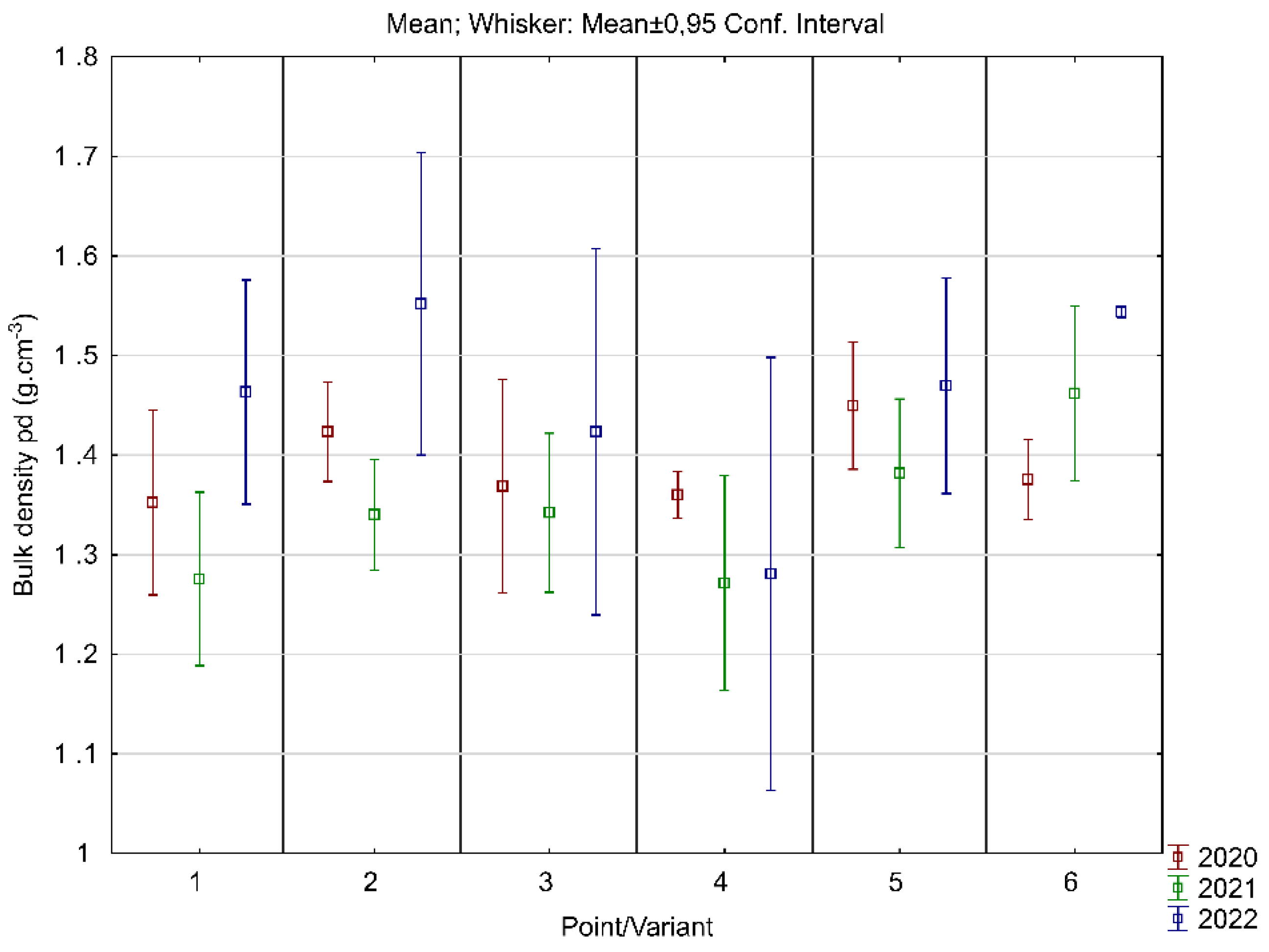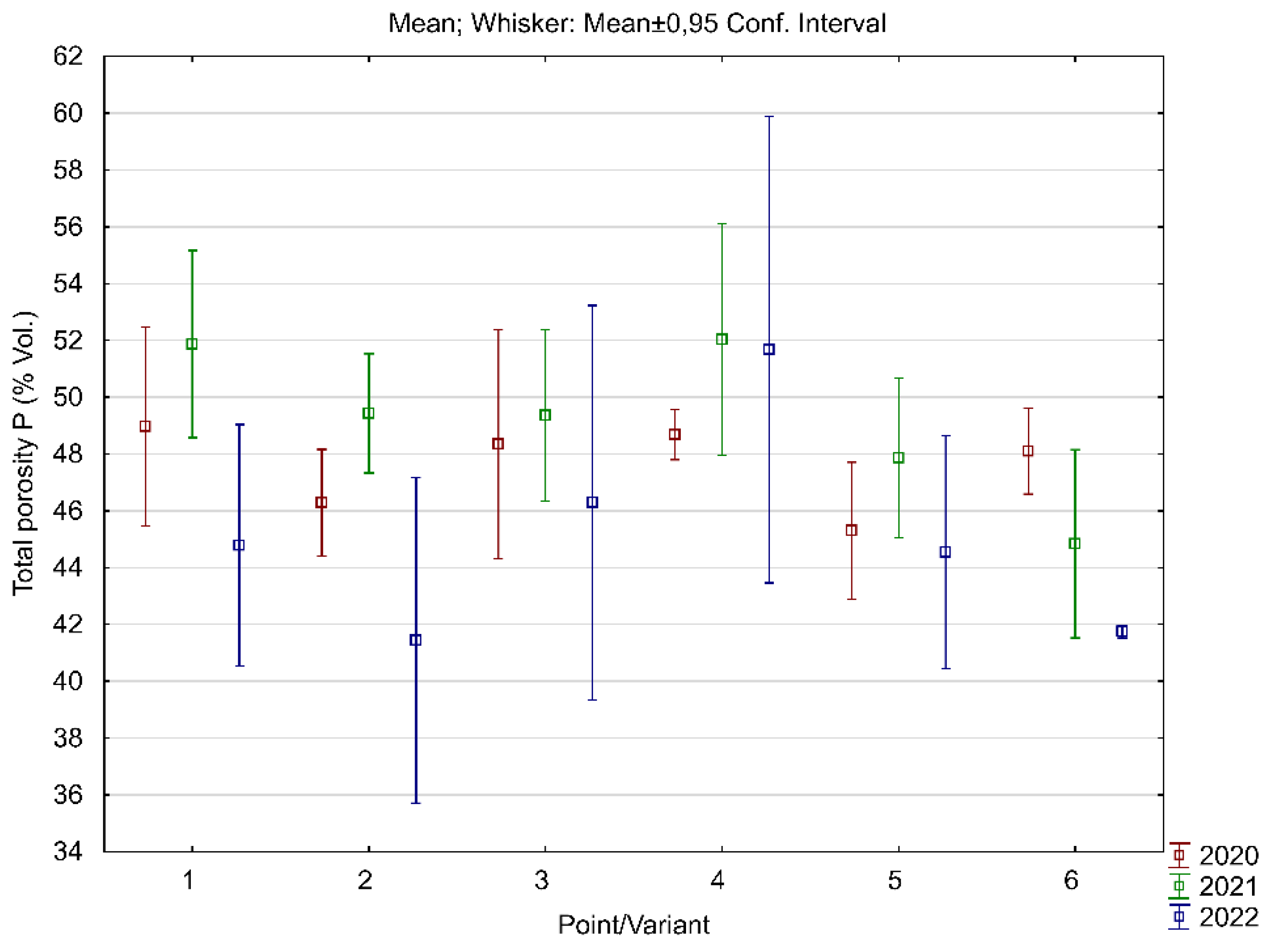Submitted:
17 November 2023
Posted:
20 November 2023
You are already at the latest version
Abstract
Keywords:
1. Introduction
2. Materials and Methods
2.1. Experimental Plot Design
2.2. Agrotechnical Operations
2.3. UAV Campaings
3. Results and Discussion
3.1. Evaluation of the Crops and Variants Using Spectral Indices
3.2. Evaluation of the Crops and Variants Using Crop Water Stress Index
3.3. Results of Intact Soil Samples
4. Conclusions
Author Contributions
Funding
Conflicts of Interest
References
- Bordoni, A.; Danesi, F.; Di Nunzio, M.; Taccari, A.; Valli, V. Ancient Wheat and Health: A Legend or the Reality? A Review on KAMUT Khorasan Wheat. Int. J. Food Sci. Nutr. 2017, 68, 278–286. [Google Scholar] [CrossRef]
- Balážová, K.; Chyba, J.; Kumhálová, J.; Mašek, J.; Petrásek, S. Monitoring of Khorasan (Triticum Turgidum Ssp. Turanicum) and Modern Kabot Spring Wheat (Triticum Aestivum) Varieties by UAV and Sensor Technologies under Different Soil Tillage. Agronomy 2021, 11, 1348. [Google Scholar] [CrossRef]
- Shanbandeh, M. Wheat–Statistics and Facts. Available online: https://www.statista.com/topics/1668/wheat/#topicOverview (accessed on 6 November 2023).
- Ghose, B. Food Security and Food Self-sufficiency in China: From Past to 2050. Food Energy Secur 2014, 3, 86–95. [Google Scholar] [CrossRef]
- Singh, R.; Krishnan, P.; Singh, V.K.; Das, B. Estimation of Yellow Rust Severity in Wheat Using Visible and Thermal Imaging Coupled with Machine Learning Models. Geocarto Int. 2023, 38. [Google Scholar] [CrossRef]
- Kurunc, A.; Tezcan, N.Y.; Bimurzayev, N. Determination of Water Stress in Wheat Crops by Thermal Images Under Mediterranean Conditions. Commun. Soil. Sci. Plant Anal. 2023, 54, 1713–1726. [Google Scholar] [CrossRef]
- Kabiri, R.; Nasibi, F.; Farahbakhsh, H. Effect of Exogenous Salicylic Acid on Some Physiological Parameters and Alleviation of Drought Stress in Nigella Sativa Plant under Hydroponic Culture. Plant Prot. Sci. 2014, 50, 43–51. [Google Scholar] [CrossRef]
- Nakhforoosh, A.; Grausgruber, H.; Kaul, H.-P.; Bodner, G. Dissection of Drought Response of Modern and Underutilized Wheat Varieties According to Passioura’s Yield-Water Framework. Front. Plant Sci. 2015, 6. [Google Scholar] [CrossRef]
- Newton, A.C.; Akar, T.; Baresel, J.P.; Bebeli, P.J.; Bettencourt, E.; Bladenopoulos, K.V.; Czembor, J.H.; Fasoula, D.A.; Katsiotis, A.; Koutis, K.; et al. Cereal Landraces for Sustainable Agriculture. A Review. Agron. Sustain. Dev. 2010, 30, 237–269. [Google Scholar] [CrossRef]
- Ficiciyan, A.; Loos, J.; Sievers-Glotzbach, S.; Tscharntke, T. More than Yield: Ecosystem Services of Traditional versus Modern Crop Varieties Revisited. Sustainability 2018, 10, 2834. [Google Scholar] [CrossRef]
- Tsegaye, B.; Berg, T. Utilization of Durum Wheat Landraces in East Shewa, Central Ethiopia: Are Home Uses an Incentive for on-Farm Conservation? Agric. Human. Values 2007, 24, 219–230. [Google Scholar] [CrossRef]
- Kapoor, D.; Bhardwaj, S.; Landi, M.; Sharma, A.; Ramakrishnan, M.; Sharma, A. The Impact of Drought in Plant Metabolism: How to Exploit Tolerance Mechanisms to Increase Crop Production. Appl. Sci. 2020, 10, 5692. [Google Scholar] [CrossRef]
- Mulla, D.J. Twenty Five Years of Remote Sensing in Precision Agriculture: Key Advances and Remaining Knowledge Gaps. Biosyst. Eng. 2013, 114, 358–371. [Google Scholar] [CrossRef]
- Amaral, L.R. do; Zerbato, C.; de Freitas, R.G.; Barbosa Júnior, M.R.; da Silva Simões, I.O.P. UAV Applications in Agriculture 4.0. Rev. Ciência Agronômica 2020, 51. [Google Scholar] [CrossRef]
- Lei, S.; Luo, J.; Tao, X.; Qiu, Z. Remote Sensing Detecting of Yellow Leaf Disease of Arecanut Based on UAV Multisource Sensors. Remote Sens (Basel) 2021, 13, 4562. [Google Scholar] [CrossRef]
- Virnodkar, S.S.; Pachghare, V.K.; Patil, V.C.; Jha, S.K. Remote Sensing and Machine Learning for Crop Water Stress Determination in Various Crops: A Critical Review. Precis. Agric. 2020, 21, 1121–1155. [Google Scholar] [CrossRef]
- Kazemi, F.; Ghanbari Parmehr, E. Evaluation of RGB Vegetation Indices Derived from UAV Images for Rice Crop Growth Monitoring. ISPRS Ann. Photogramm. Remote Sens. Spat. Inf. Sci. 2022. [Google Scholar] [CrossRef]
- Khan, A.; Upadhyay, C.S.; Gerritsma, M. Spectral Element Method for Parabolic Interface Problems. Comput. Methods Appl. Mech. Eng. 2018, 337, 66–94. [Google Scholar] [CrossRef]
- Kamenova, I.; Dimitrov, P. Evaluation of Sentinel-2 Vegetation Indices for Prediction of LAI, FAPAR and FCover of Winter Wheat in Bulgaria. Eur. J. Remote Sens. 2021, 54, 89–108. [Google Scholar] [CrossRef]
- Domínguez, J.A.; Kumhálová, J.; Novák, P. Winter Oilseed Rape and Winter Wheat Growth Prediction Using Remote Sensing Methods. Plant Soil. Environ. 2015, 61, 410–416. [Google Scholar] [CrossRef]
- Gitelson, A.A.; Kaufman, Y.J.; Merzlyak, M.N. Use of a Green Channel in Remote Sensing of Global Vegetation from EOS-MODIS. Remote Sens. Environ. 1996, 58, 289–298. [Google Scholar] [CrossRef]
- Frampton, W.J.; Dash, J.; Watmough, G.; Milton, E.J. Evaluating the Capabilities of Sentinel-2 for Quantitative Estimation of Biophysical Variables in Vegetation. ISPRS J. Photogramm. Remote Sens. 2013, 82, 83–92. [Google Scholar] [CrossRef]
- Mangewa, L.J.; Ndakidemi, P.A.; Alward, R.D.; Kija, H.K.; Bukombe, J.K.; Nasolwa, E.R.; Munishi, L.K. Comparative Assessment of UAV and Sentinel-2 NDVI and GNDVI for Preliminary Diagnosis of Habitat Conditions in Burunge Wildlife Management Area, Tanzania. Earth 2022, 3, 769–787. [Google Scholar] [CrossRef]
- Funghi, C.; Heim, R.H.J.; Schuett, W.; Griffith, S.C.; Oldeland, J. Estimating Food Resource Availability in Arid Environments with Sentinel 2 Satellite Imagery. PeerJ 2020, 8, e9209. [Google Scholar] [CrossRef]
- Potter, C.; Li, S.; Huang, S.; Crabtree, R.L. Analysis of Sapling Density Regeneration in Yellowstone National Park with Hyperspectral Remote Sensing Data. Remote Sens. Environ. 2012, 121, 61–68. [Google Scholar] [CrossRef]
- Idso, S.B.; Jackson, R.D.; Pinter, P.J.; Reginato, R.J.; Hatfield, J.L. Normalizing the Stress-Degree-Day Parameter for Environmental Variability. Agric. Meteorol. 1981, 24, 45–55. [Google Scholar] [CrossRef]
- Alchanatis, V.; Cohen, Y.; Cohen, S.; Moller, M.; Sprinstin, M.; Meron, M.; Tsipris, J.; Saranga, Y.; Sela, E. Evaluation of Different Approaches for Estimating and Mapping Crop Water Status in Cotton with Thermal Imaging. Precis. Agric. 2010, 11, 27–41. [Google Scholar] [CrossRef]
- Jones, H.G.; Stoll, M.; Santos, T.; de Sousa, C.; Chaves, M.M.; Grant, O.M. Use of Infrared Thermography for Monitoring Stomatal Closure in the Field: Application to Grapevine. J. Exp. Bot. 2002, 53, 2249–2260. [Google Scholar] [CrossRef]
- Costa, J.D.O.; Coelho, R.D.; Barros, T.H.D.S.; Fraga Júnior, E.F.; Fernandes, A.L.T. Canopy Thermal Response to Water Deficit of Coffee Plants under Drip Irrigation. Irrig. Drain. 2020, 69, 472–482. [Google Scholar] [CrossRef]
- Pou, A.; Diago, M.P.; Medrano, H.; Baluja, J.; Tardaguila, J. Validation of Thermal Indices for Water Status Identification in Grapevine. Agric. Water Manag. 2014, 134, 60–72. [Google Scholar] [CrossRef]
- Wang, H.; Li, X.; Li, X.; Wang, J.; Li, X.; Guo, Q.; Yu, Z.; Yang, T.; Zhang, H. Long-Term No-Tillage and Different Residue Amounts Alter Soil Microbial Community Composition and Increase the Risk of Maize Root Rot in Northeast China. Soil. Tillage Res. 2020, 196, 104452. [Google Scholar] [CrossRef]
- Debska, B.; Jaskulska, I.; Jaskulski, D. Method of Tillage with the Factor Determining the Quality of Organic Matter. Agronomy 2020, 10, 1250. [Google Scholar] [CrossRef]
- Almagro, M.; Garcia-Franco, N.; Martínez-Mena, M. The Potential of Reducing Tillage Frequency and Incorporating Plant Residues as a Strategy for Climate Change Mitigation in Semiarid Mediterranean Agroecosystems. Agric. Ecosyst. Environ. 2017, 246, 210–220. [Google Scholar] [CrossRef]
- Melero, S.; Panettieri, M.; Madejón, E.; Macpherson, H.G.; Moreno, F.; Murillo, J.M. Implementation of Chiselling and Mouldboard Ploughing in Soil after 8 Years of No-till Management in SW, Spain: Effect on Soil Quality. Soil. Tillage Res. 2011, 112, 107–113. [Google Scholar] [CrossRef]
- ING. Andrea Hrabalová. In YEARBOOK 202-Organic Farming in the Czech Republic; Ministry of Agriculture of the Czech Republic: Prag, 2023. [Google Scholar]
- Mašek, J.; Novák, P.; Kroulík, M.; Chyba, J. The Quality Evaluation of Different Soil Tillage Technologies. Agron. Res. 2014, 12. [Google Scholar]
- Cheţan, F.; Rusu, T.; Călugăr, R.; Chețan, C.; Şimon, A.; Ceclan, A.; Bărdaș, M.; Mintaș, O. Research on the Interdependence Linkages between Soil Tillage Systems and Climate Factors on Maize Crop. Land (Basel) 2022, 11, 1731. [Google Scholar] [CrossRef]
- Chirita, S.; Rusu, T.; Urda, C.; Chetan, F.; Racz, I. Winter Wheat Yield and Quality Depending on Chemical Fertilization, Different Treatments and Tillage Systems. AgroLife Sci. J. 2023, 12, 34–39. [Google Scholar] [CrossRef]
- Özpinar, S. Anil Çay Effects of Minimum and Conventional Tillage Systems on Soil Properties and Yield of Winter Wheat (Triticum Aestivum L.) in Clay-Loam in the Çanakkale Region. Turk. J. Agric. For. 2005, 29, 9–18. [Google Scholar]
- Šíp, V.; Růžek, P.; Chrpová, J.; Vavera, R.; Kusá, H. The Effect of Tillage Practice, Input Level and Environment on the Grain Yield of Winter Wheat in the Czech Republic. Field Crops Res. 2009, 113, 131–137. [Google Scholar] [CrossRef]
- Noor, R.S.; Hussain, F.; Umair, M. EVALUATING SELECTED SOIL PHYSICAL PROPERTIES UNDER DIFFERENT SOIL TILLAGE SYSTEMS IN ARID SOUTHEAST RAWALPINDI, PAKISTAN. J. CleanWAS 2020, 4, 56–60. [Google Scholar] [CrossRef]
- Florian Ellsäßer CWSI Is a QGIS3 Plugin That Helps to Calculate the CWSI (Crop Water Stress Index) from Thermal Images.
- Jones, H.G. Plants and Microclimate (Second Edition); Cambridge University Press: Cambridge, 1992. [Google Scholar]
- Irmak, S.; Haman, D.Z.; Bastug, R. Determination of Crop Water Stress Index for Irrigation Timing and Yield Estimation of Corn. Agron. J. 2000, 92, 1221–1227. [Google Scholar] [CrossRef]
- Kumhálová, J.; Kumhála, F.; Kroulík, M.; Matějková, Š. The Impact of Topography on Soil Properties and Yield and the Effects of Weather Conditions. Precis. Agric. 2011, 12, 813–830. [Google Scholar] [CrossRef]
- Mullan, D.J.; Reynolds, M.P. Quantifying Genetic Effects of Ground Cover on Soil Water Evaporation Using Digital Imaging. Funct. Plant Biol. 2010, 37, 703. [Google Scholar] [CrossRef]
- Kaur, S.; Kaur, R.; Chauhan, B.S. Understanding Crop-Weed-Fertilizer-Water Interactions and Their Implications for Weed Management in Agricultural Systems. Crop Prot. 2018, 103, 65–72. [Google Scholar] [CrossRef]
- Mehra, P.; Kumar, P.; Bolan, N.; Desbiolles, J.; Orgill, S.; Denton, M.D. Changes in Soil-Pores and Wheat Root Geometry Due to Strategic Tillage in a No-Tillage Cropping System. Soil. Res. 2021, 59, 83. [Google Scholar] [CrossRef]
- Woźniak, A.; Rachoń, L. Effect of Tillage Systems on the Yield and Quality of Winter Wheat Grain and Soil Properties. Agriculture 2020, 10, 405. [Google Scholar] [CrossRef]
- Micucci, F.G.; Taboada, M.A. Soil Physical Properties and Soybean (Glycine Max, Merrill) Root Abundance in Conventionally- and Zero-Tilled Soils in the Humid Pampas of Argentina. Soil. Tillage Res. 2006, 86, 152–162. [Google Scholar] [CrossRef]
- Farooq, M.; Wahid, A.; Kobayashi, N.; Fujita, D.; Basra, S.M.A. Plant Drought Stress: Effects, Mechanisms and Management. Agron. Sustain. Dev. 2009, 29, 185–212. [Google Scholar] [CrossRef]
- Kumhálová, J.; Kumhála, F.; Novák, P.; Matějková, Š. Airborne Laser Scanning Data as a Source of Field Topographical Characteristics. Plant Soil. Environ. 2013, 59, 423–431. [Google Scholar] [CrossRef]
- Richards, R.A.; Rebetzke, G.J.; Watt, M.; Condon, A.G. (Tony); Spielmeyer, W.; Dolferus, R. Breeding for Improved Water Productivity in Temperate Cereals: Phenotyping, Quantitative Trait Loci, Markers and the Selection Environment. Funct. Plant Biol. 2010, 37, 85. [Google Scholar] [CrossRef]
- Ali, F.; Umar, M.; Siddiqui, Z.S. Comparative Physiological Assessment of Some Edible Oil Seed Crops under Drought Stress Environment Using Fluorescence and IR Imaging Techniques. Pak. J. Bot. 2021, 53. [Google Scholar] [CrossRef]
- Hoffmann, H.; Jensen, R.; Thomsen, A.; Nieto, H.; Rasmussen, J.; Friborg, T. Crop Water Stress Maps for an Entire Growing Season from Visible and Thermal UAV Imagery. Biogeosciences 2016, 13, 6545–6563. [Google Scholar] [CrossRef]
- Feiziasl, V.; Jafarzadeh, J.; Sadeghzadeh, B.; Mousavi Shalmani, M.A. Water Deficit Index to Evaluate Water Stress Status and Drought Tolerance of Rainfed Barley Genotypes in Cold Semi-Arid Area of Iran. Agric. Water Manag. 2022, 262, 107395. [Google Scholar] [CrossRef]
- Mohammadi, K.; Rokhzadi, A.; Saberali, S.F.; Byzedi, M.; Karimi Nezhad, M.T. Tillage Effects on Soil Properties and Wheat Cultivars Traits. Arch. Agron. Soil. Sci. 2013, 59, 1625–1641. [Google Scholar] [CrossRef]
- Khorami, S.; Kazemeini, S.; Afzalinia, S.; Gathala, M. Changes in Soil Properties and Productivity under Different Tillage Practices and Wheat Genotypes: A Short-Term Study in Iran. Sustainability 2018, 10, 3273. [Google Scholar] [CrossRef]
- Houshyar, E.; Esmailpour, M. The Impacts of Tillage, Fertilizer and Residue Managements on the Soil Properties and Wheat Production in a Semi-Arid Region of Iran. J. Saudi Soc. Agric. Sci. 2020, 19, 225–232. [Google Scholar] [CrossRef]
- Topa, D.; Cara, I.G.; Jităreanu, G. Long Term Impact of Different Tillage Systems on Carbon Pools and Stocks, Soil Bulk Density, Aggregation and Nutrients: A Field Meta-Analysis. Catena (Amst) 2021, 199, 105102. [Google Scholar] [CrossRef]
- Luan, X.; Vico, G. Canopy Temperature and Heat Stress Are Increased by Compound High Air Temperature and Water Stress and Reduced by Irrigation–a Modeling Analysis. Hydrol. Earth Syst. Sci. 2021, 25, 1411–1423. [Google Scholar] [CrossRef]
- James, A.T.; Lawn, R.J.; Cooper, M. Genotypic Variation for Drought Stress Response Traits in Soybean. II. Inter-Relations between Epidermal Conductance, Osmotic Potential, Relative Water Content, and Plant Survival. Aust. J. Agric. Res. 2008, 59, 670. [Google Scholar] [CrossRef]
- Liebhard, G.; Klik, A.; Neugschwandtner, R.W.; Nolz, R. Effects of Tillage Systems on Soil Water Distribution, Crop Development, and Evaporation and Transpiration Rates of Soybean. Agric. Water Manag. 2022, 269, 107719. [Google Scholar] [CrossRef]
- Blanco-Canqui, H.; Ruis, S.J. No-Tillage and Soil Physical Environment. Geoderma 2018, 326, 164–200. [Google Scholar] [CrossRef]




| Month | Average Temperature (°C) | Sum Precipitation (mm) | ||||||
|---|---|---|---|---|---|---|---|---|
| 2020 | 2021 | 2022 | 2023 | 2020 | 2021 | 2022 | 2023 | |
| April | 9.8 | 5.1 | 6.0 | 6.2 | 17.27 | 13.71 | 39.88 | 83.82 |
| May | 11.3 | 10.2 | 14.0 | 12.4 | 166.64 | 35.3 | 43.12 | 35.78 |
| June | 15.7 | 19.8 | 18.3 | 16.5 | 206.23 | 144.53 | 86.84 | 45.77 |
| July | 18.3 | 19.4 | 18.2 | 19.4 | 136.65 | 135.36 | 58.47 | 68.27 |
| August | 18.0 | 16.7 | 18.7 | 18.5 | 148.48 | 174.76 | 117.32 | 140.37 |
| Date of scanning | Growth stage | Temperature in time of measurement (°C) |
|---|---|---|
| 18 May 2020 | BBCH 25 tillering | 18.2 |
| 11 June 2020 | BBCH 35 stem elongation | 18.4 |
| 2 July 2020 | BBCH 68 flowering | 20.9 |
| 14 July 2020 | BBCH 75 spikes forming | 24.5 |
| 24 May 2021 | BBCH 26 tillering | 11.8 |
| 23 June 2021 | BBCH 49 end of stem elongation | 21.2 |
| 8 July 2021 | BBCH 67 flowering | 19.7 |
| 21 July 2021 | BBCH 79 spikes forming | 19.2 |
| 16 May 2022 | BBCH 25 tillering | 26.3 |
| 8 June 2022 | BBCH 38 stem elongation | 23.4 |
| 13 July 2022 | BBCH 69 flowering | 23.1 |
| 30 May 2023 | BBCH 25 tillering | 19.9 |
| 13 June 2023* | BBCH 35 stem elongation | 20.5 |
| 11 July 2023 | BBCH 68 flowering | 29.5 |
| Sensor/Camera | MicaSense RedEdge MX | S.O.D.A. / DuetT | IR sensor / DuetT |
|---|---|---|---|
| BLUE (nm) | 475 (20) | 450 (100) | - |
| GREEN (nm) | 560 (20) | 520 (100) | - |
| RED (nm) | 668 (10) | 660 (130) | - |
| RED EDGE (nm) | 717 (10) | - | - |
| NIR (nm) | 840 (40) | - | - |
| Thermal (µm) | - | - | 7.5-13.5 |
| Lateral overlap | 75 % | 83 % | 75 % |
| Longitudinal overlap | 75 % | 84 % | 80 % |
| Flight height | 88 m AED | 91.8 m AED | 91.8 m AED |
| Spatial resolution | 6.0 cm/px | 2.1 cm/px | 12 cm/px |
| Spectral Index | Algorithm | Developed by | References |
|---|---|---|---|
| Normalized Difference Vegetation Index (NDVI) | (NIR–RED)/(NIR + RED) | Biomass, structure, vigor | Rouse et al. (1974) |
| Green Normalized Difference Vegetation Index (GNDVI) | (NIR–GREEN)/(NIR+GREEN) | Chlorophyll | Gitelson et al. (1996) |
| Chlorophyll Index Red Edge (CIR) | (NIR/RedEdge)-1 | Chlorophyll | Gitelson et al. (2005) |
| Digital Terrain Model (DTM) | Terrain a.s.l. (m) | ||
| Crop Water Stress Index (CWSI) | Water stress | Katimbo et al. (2022) |
| Plots | Average | Tillering | Stem Elongation | Late stages | ||||||||||
|---|---|---|---|---|---|---|---|---|---|---|---|---|---|---|
| Khorasan 1 CT | 0.38 | 0.45 | 0.30 | 0.37 | ||||||||||
| Khorasan 2 MTC | 0.34 | 0.37 | 0.32 | 0.33 | ||||||||||
| Khorasan 3 MTD | 0.32 | 0.36 | 0.31 | 0.31 | ||||||||||
| Kabot 1 CT | 0.29 | 0.40 | 0.23 | 0.26 | ||||||||||
| Kabot 2 MTC | 0.30 | 0.37 | 0.23 | 0.30 | ||||||||||
| Kabot 3 MTD | 0.28 | 0.32 | 0.22 | 0.28 | ||||||||||
| Plots | 18 May 2020 | 11 June 2020 | 2 July 2020 | 14 July 2020 | 24 May 2021 | 23 June 2021 | 8 July 2021 | 21 July 2021 | 16 May 2022 | 8 June 2022 | 13 July 2022 | 30 May 2023 | 11 July 2023 | |
| Khorasan | CT | 0.61 | 0.12 | 0.58 | 0.16 | 0.1 | 0.13 | 0.09 | 0.17 | 0.66 | 0.64 | 0.31 | 0.42 | 0.92 |
| MTC | 0.46 | 0.15 | 0.52 | 0.12 | 0.11 | 0.14 | 0.11 | 0.18 | 0.5 | 0.67 | 0.24 | 0.39 | 0.82 | |
| MTD | 0.53 | 0.17 | 0.57 | 0.15 | 0.01 | 0.15 | 0.13 | 0.16 | 0.39 | 0.62 | 0.23 | 0.52 | 0.59 | |
| Kabot | CT | 0.64 | 0.08 | 0.35 | 0.09 | 0.08 | 0.16 | 0.14 | 0.19 | 0.37 | 0.44 | 0.21 | 0.49 | 0.56 |
| MTC | 0.32 | 0.17 | 0.46 | 0.09 | 0.11 | 0.15 | 0.17 | 0.15 | 0.33 | 0.37 | 0.19 | 0.72 | 0.71 | |
| MTD | 0.18 | 0.15 | 0.43 | 0.12 | 0.12 | 0.09 | 0.24 | 0.13 | 0.23 | 0.41 | 0.19 | 0.73 | 0.58 | |
| Tillering | |||||||||||
|---|---|---|---|---|---|---|---|---|---|---|---|
| Var | Mul R | Var | Mul R | Var | Mul R | Var | Mul R | Var | Mul R | Var | Mul R |
| Khorasan 1 CT | Khorasan 2 MTC | Khorasan 3 MTD | Kabot 1 CT | Kabot 2 MTC | Kabot 3 MTD | ||||||
| Date | 0.31 | Date | 0.47 | Date | 0.36 | Date | 0.08 | Date | 0.18 | CIR | 0.24 |
| NDVI | 0.48 | NDVI | 0.64 | NDVI | 0.5 | CIR | 0.32 | CIR | 0.33 | GNDVI | 0.44 |
| GNDVI | 0.74 | GNDVI | 0.74 | GNDVI | 0.58 | GNDVI | 0.42 | GNDVI | 0.68 | NDVI | 0.44 |
| DTM | 0.75 | CIR | 0.76 | CIR | 0.62 | NDVI | 0.48 | NDVI | 0.68 | Date | 0.44 |
| CIR | 0.76 | DTM | 0.76 | DTM | 0.62 | DTM | 0.51 | DTM | 0.68 | DTM | 0.44 |
| R2 | 0.57 | 0.58 | 0.38 | 0.26 | 0.46 | 0.2 | |||||
| Stem Elongation | |||||||||||
| GNDVI | 0.92 | GNDVI | 0.9 | GNDVI | 0.86 | GNDVI | 0.8 | GNDVI | 0.71 | NDVI | 0.75 |
| CIR | 0.93 | DTM | 0.91 | CIR | 0.087 | Date | 0.8 | Date | 0.73 | DTM | 0.76 |
| DTM | 0.94 | NDVI | 0.92 | DTM | 0.87 | DTM | 0.81 | DTM | 0.75 | Date | 0.77 |
| Date | 0.94 | CIR | 0.93 | Date | 0.88 | NDVI | 0.81 | CIR | 0.76 | GNDVI | 0.78 |
| NDVI | 0.94 | Date | 0.93 | NDVI | 0.88 | CIR | 0.81 | NDVI | 0.76 | CIR | 0.79 |
| R2 | 0.88 | 0.86 | 0.77 | 0.65 | 0.58 | 0.63 | |||||
| Flowering | |||||||||||
| Date | 0.81 | NDVI | 0.82 | NDVI | 0.7 | NDVI | 0.7 | NDVI | 0.8 | NDVI | 0.81 |
| GNDVI | 0.86 | Date | 0.85 | DTM | 0.76 | DTM | 0.75 | DTM | 0.84 | Date | 0.82 |
| CIR | 0.86 | DTM | 0.87 | CIR | 0.77 | Date | 0.76 | Date | 0.86 | GNDVI | 0.83 |
| DTM | 0.87 | GNDVI | 0.88 | Date | 0.78 | CIR | 0.77 | GNDVI | 0.86 | CIR | 0.84 |
| NDVI | 0.87 | CIR | 0.88 | GNDVI | 0.79 | GNDVI | 0.77 | CIR | 0.86 | DTM | 0.84 |
| R2 | 0.76 | 0.77 | 0.62 | 0.59 | 0.75 | 0.7 | |||||
Disclaimer/Publisher’s Note: The statements, opinions and data contained in all publications are solely those of the individual author(s) and contributor(s) and not of MDPI and/or the editor(s). MDPI and/or the editor(s) disclaim responsibility for any injury to people or property resulting from any ideas, methods, instructions or products referred to in the content. |
© 2023 by the authors. Licensee MDPI, Basel, Switzerland. This article is an open access article distributed under the terms and conditions of the Creative Commons Attribution (CC BY) license (http://creativecommons.org/licenses/by/4.0/).





